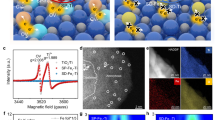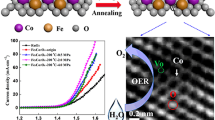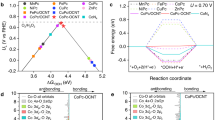Abstract
Unlocking of the extremely inert C=O bond during electrochemical CO2 reduction demands subtle regulation on a key “resource”, protons, necessary for intermediate conversion but also readily trapped in water splitting, which is still challenging for developing efficient single-atom catalysts limited by their structural simplicity usually incompetent to handle this task. Incorporation of extra functional units should be viable. Herein, a proton deployment strategy is demonstrated via “atomic and nanostructured iron (A/N-Fe) pairs”, comprising atomically dispersed iron active centers spin-polarized by nanostructured iron carbide ferromagnets, to boost the critical protonation steps. The as-designed catalyst displays a broad window (300 mV) for CO selectivity > 90% (98% maximum), even outperforming numerous cutting-edge M—N—C systems. The well-placed control of proton dynamics by A/N-Fe can promote *COOH/*CO formation and simultaneously suppress H2 evolution, benefiting from the magnetic-proximity-induced exchange splitting (spin polarization) that properly adjusts energy levels of the Fe sites’ d-shells, and further those of the adsorbed intermediates’ antibonding molecular orbitals.

Similar content being viewed by others
References
Grim R G, Huang Z, Guarnieri M T, Ferrell J R, Tao L, Schaidle J A. Transforming the carbon economy: challenges and opportunities in the convergence of low-cost electricity and reductive CO2 utilization. Energy & Environmental Science, 2020, 13(2): 472–494
Kortlever R, Shen J, Schouten K J P, Calle-Vallejo F, Koper M T M. Catalysts and reaction pathways for the electrochemical reduction of carbon dioxide. Journal of Physical Chemistry Letters, 2015, 6(20): 4073–4082
Birdja Y Y, Perez-Gallent E, Figueiredo M C, Gottle A J, Calle-Vallejo F, Koper M T M. Advances and challenges in understanding the electrocatalytic conversion of carbon dioxide to fuels. Nature Energy, 2019, 4(9): 732–745
Ross M B, De Luna P, Li Y, Dinh C T, Kim D, Yang P, Sargent E H. Designing materials for electrochemical carbon dioxide recycling. Nature Catalysis, 2019, 2(8): 648–658
Zhang Y J, Sethuraman V, Michalsky R, Peterson A A. Competition between CO2 reduction and H2 evolution on transition-metal electrocatalysts. ACS Catalysis, 2014, 4(10): 3742–3748
Cave E R, Shi C, Kuhl K P, Hatsukade T, Abram D N, Hahn C, Chan K, Jaramillo T F. Trends in the catalytic activity of hydrogen evolution during CO2 electroreduction on transition metals. ACS Catalysis, 2018, 8(4): 3035–3040
Zheng T, Jiang K, Wang H. Recent advances in electrochemical CO2-to-CO conversion on heterogeneous catalysts. Advanced Materials, 2018, 30(48): 1802066
Wang Y, Liu Y, Liu W, Wu J, Li Q, Feng Q, Chen Z, Xiong X, Wang D, Lei Y. Regulating the coordination structure of metal single atoms for efficient electrocatalytic CO2 reduction. Energy & Environmental Science, 2020, 13(12): 4609–4624
Pan Y, Zhang C, Liu Z, Chen C, Li Y D. Structural regulation with atomic-level precision: from single-atomic site to diatomic and atomic interface catalysis. Matter, 2020, 2(1): 78–110
Zang W, Kou Z, Pennycook S J, Wang J. Heterogeneous single atom electrocatalysis, where “singles” are “married”. Advanced Energy Materials, 2020, 10(9): 1903181
Jiao J, Lin R, Liu S, Cheong W C, Zhang C, Chen Z, Pan Y, Tang J, Wu K, Hung S F, Chen H M, Zheng L, Lu Q, Yang X, Xu B, Xiao H, Li J, Wang D, Peng Q, Chen C, Li Y. Copper atom-pair catalyst anchored on alloy nanowires for selective and efficient electrochemical reduction of CO2. Nature Chemistry, 2019, 11(3): 222–228
Liu C, Wu Y, Sun K, Fang J, Huang A, Pan Y, Cheong W C, Zhuang Z, Zhuang Z, Yuan Q, Xin H L, Zhang C, Zhang J, Xiao H, Chen C, Li Y. Constructing FeN4/graphitic nitrogen atomic interface for high-efficiency electrochemical CO2 reduction over a broad potential window. Chem, 2021, 7(5): 1297–1307
Bondue C J, Graf M, Goyal A, Koper M T M. Suppression of hydrogen evolution in acidic electrolytes by electrochemical CO2 reduction. Journal of the American Chemical Society, 2021, 143(1): 279–285
Ma W, Xie S, Zhang X G, Sun F, Kang J, Jiang Z, Zhang Q, Wu D Y, Wang Y. Promoting electrocatalytic CO2 reduction to formate via sulfur-boosting water activation on indium surfaces. Nature Communications, 2019, 10(1): 892
Wang X, Sang X, Dong C L, Yao S, Shuai L, Lu J, Yang B, Li Z, Lei L, Qiu M, Dai L, Hou Y. Proton capture strategy for enhancing electrochemical CO2 reduction on atomically dispersed metal-nitrogen active sites. Angewandte Chemie International Edition, 2021, 60(21): 11959–11965
Ju W, Bagger A, Hao G P, Sofia Varela A, Sinev I, Bon V, Roldan Cuenya B, Kaskel S, Rossmeisl J, Strasser P. Understanding activity and selectivity of metal-nitrogen-doped carbon catalysts for electrochemical reduction of CO2. Nature Communications, 2017, 8(1): 944
Zhang H, Li J, Xi S, Du Y, Hai X, Wang J, Xu H, Wu G, Zhang J, Lu J, Wang J. A graphene-supported single-atom FeN5 catalytic site for efficient electrochemical CO2 reduction. Angewandte Chemie International Edition, 2019, 58(42): 14871–14876
Li J, Mao S, Hou Y, Lei L, Yuan C. 3D edge-enriched Fe3C@C nanocrystals with a core-shell structure grown on reduced graphene oxide networks for efficient oxygen reduction reaction. ChemSusChem, 2018, 11(18): 3292–3298
Zhang W, Yin J, Sun M, Wang W, Chen C, Altunkaya M, Emwas A H, Han Y, Schwingenschlogl U, Alshareef H N. Direct pyrolysis of supermolecules: an ultrahigh edge-nitrogen doping strategy of carbon anodes for potassium-ion batteries. Advanced Materials, 2020, 32(25): 2000732
Shao Y, Pang R, Shi X. Stability of two-dimensional iron carbides suspended across graphene pores: first-principles particle swarm optimization. Journal of Physical Chemistry C, 2015, 119(40): 22954–22960
Zutic I, Matos-Abiague A, Scharf B, Dery H, Belashchenko K. Proximitized materials. Materials Today, 2019, 22: 85–107
Stöhr J, Siegmann H C. Magnetism: From Fundamentals to Nanoscale Dynamics. Berlin: Springer, 2006: 235–240
Marder M P. Condensed Matter Physics. Hoboken: Wiley, 2010: 811–813
Norskov J K, Bligaard T, Rossmeisl J, Christensen C H. Towards the computational design of solid catalysts. Nature Chemistry, 2009, 1(1): 37–46
Zhao Z J, Liu S, Zha S, Cheng D, Studt F, Henkelman G, Gong J. Theory-guided design of catalytic materials using scaling relationships and reactivity descriptors. Nature Reviews Materials, 2019, 4(12): 792–804
Ren X, Wu T Z, Sun Y M, Li Y, Xian G Y, Liu X H, Shen C M, Gracia J, Gao H J, Yang H T, Xu Z J. Spin-polarized oxygen evolution reaction under magnetic field. Nature Communications, 2021, 12(1): 2608
Wu T Z, Ren X, Sun Y M, Sun S N, Xian G Y, Scherer G G, Fisher A C, Mandler D, Ager J W, Grimaud A, Wang J, Shen C, Yang H, Gracia J, Gao H J, Xu Z J. Spin pinning effect to reconstructed oxyhydroxide layer on ferromagnetic oxides for enhanced water oxidation. Nature Communications, 2021, 12(1): 3634
Demtröder W. Atoms, Molecules and Photons: An Introduction to Atomic-, Molecular- and Quantum Physics. Berlin: Springer, 2018: 320–322
Zhang X, Li X Q, Zhang D, Su N Q, Yang W T, Everitt H O, Liu J. Product selectivity in plasmonic photocatalysis for carbon dioxide hydrogenation. Nature Communications, 2017, 8(1): 14542
Jiang W J, Gu L, Li L, Zhang Y, Zhang X, Zhang L J, Wang J Q, Hu J S, Wei Z, Wan L J. Understanding the high activity of Fe-N-C electrocatalysts in oxygen reduction: Fe/Fe3C nanoparticles boost the activity of Fe-Nx. Journal of the American Chemical Society, 2016, 138(10): 3570–3578
Hu J, Wang S, Yu J, Nie W, Sun J, Wang S. Duet Fe3C and FeNx sites for H2O2 generation and activation toward enhanced electro-Fenton performance in wastewater treatment. Environmental Science & Technology, 2021, 55(2): 1260–1269
Li J, Ghoshal S, Liang W, Sougrati M T, Jaouen F, Halevi B, McKinney S, McCool G, Ma C, Yuan X, Ma Z F, Mukerjee S, Jia Q. Structural and mechanistic basis for the high activity of Fe—N—C catalysts toward oxygen reduction. Energy & Environmental Science, 2016, 9(7): 2418–2432
Gu J, Hsu C S, Bai L, Chen H M, Hu X. Atomically dispersed Fe3+ sites catalyze efficient CO2 electroreduction to CO. Science, 2019, 364(6445): 1091–1094
Burdyny T, Smith W A. CO2 reduction on gas-diffusion electrodes and why catalytic performance must be assessed at commercially-relevant conditions. Energy & Environmental Science, 2019, 12(5): 1442–1453
Firet N J, Smith W A. Probing the reaction mechanism of CO2 electroreduction over Ag films via operando infrared spectroscopy. ACS Catalysis, 2017, 7(1): 606–612
Zhu S, Jiang B, Cai W B, Shao M. Direct observation on reaction intermediates and the role of bicarbonate anions in CO2 electrochemical reduction reaction on Cu surfaces. Journal of the American Chemical Society, 2017, 139(44): 15664–15667
Günzler H, Gremlich H U I R. Spectroscopy: an Introduction. Weinheim: Wiley, 2002: 14–16
Rankin D W H, Mitzel N W, Morrison C A. Structural Methods in Molecular Inorganic Chemistry. Chichester: Wiley, 2013: 237–238
Kettle S F A. Physical Inorganic Chemistry: A Coordination Chemistry Approach. Berlin: Springer, 1996: 229–230
Bell R P. The Proton in Chemistry. London: Chapman & Hall, 1973: 232–235
Goyal A, Marcandalli G, Mints V A, Koper M T M. Competition between CO2 reduction and hydrogen evolution on a gold electrode under well-defined mass transport conditions. Journal of the American Chemical Society, 2020, 142(9): 4154–4161
Hammes-Schiffer S. Theory of proton-coupled electron transfer in energy conversion processes. Accounts of Chemical Research, 2009, 42(12): 1881–1889
Liu E, Jiao L, Li J, Stracensky T, Sun Q, Mukerjee S, Jia Q. Interfacial water shuffling the intermediates of hydrogen oxidation and evolution reactions in aqueous media. Energy & Environmental Science, 2020, 13(9): 3064–3074
Goldsmith Z K, Lam Y C, Soudackov A V, Hammes-Schiffer S. Proton discharge on a gold electrode from triethylammonium in acetonitrile: theoretical modeling of potential-dependent kinetic isotope effects. Journal of the American Chemical Society, 2019, 141(2): 1084–1090
Lam Y C, Soudackov A V, Hammes-Schiffer S. Theory of electrochemical proton-coupled electron transfer in diabatic vibronic representation: application to proton discharge on metal electrodes in alkaline solution. Journal of Physical Chemistry C, 2020, 124(50): 27309–27322
Deng D H, Yu L, Chen X Q, Wang G X, Jin L, Pan X L, Deng J, Sun G Q, Bao X H. Iron encapsulated within pod-like carbon nanotubes for oxygen reduction reaction. Angewandte Chemie International Edition, 2013, 52(1): 371–375
Hu Y, Jensen J O, Zhang W, Cleemann L N, Xing W, Bjerrum N J, Li Q. Hollow spheres of iron carbide nanoparticles encased in graphitic layers as oxygen reduction catalysts. Angewandte Chemie International Edition, 2014, 53(14): 3675–3679
Xie J, Wang Y. Recent development of CO2 electrochemistry from Li—CO2 batteries to Zn—CO2 batteries. Accounts of Chemical Research, 2019, 52(6): 1721–1729
Wang X, Xie J, Ghausi M A, Lv J, Huang Y, Wu M, Wang Y, Yao J. Rechargeable Zn—CO2 electrochemical cells mimicking two-step photosynthesis. Advanced Materials, 2019, 31(17): 1807807
Liang X, Xiao J, Weng W, Xiao W. Electrochemical reduction of carbon dioxide and iron oxide in molten salts to Fe/Fe3C modified carbon for electrocatalytic oxygen evolution. Angewandte Chemie International Edition, 2021, 60(4): 2120–2124
Acknowledgements
We sincerely thank Dr. Guoqiang Shen (Tianjin University) for his multitude of instructive advice on theory, logic and particulars. This work was financially supported by National Natural Science Foundation of China (Grant Nos. 22075245, 21922811, 21878270, and 21961160742), Zhejiang Provincial Natural Science Foundation of China (Grant No. LR19B060002), Fundamental Research Funds for the Central Universities (Grant No. 2020XZZX002-09), Leading Innovative and Entrepreneur Team Introduction Program of Zhejiang (Grant No. 2019R01006), Startup Foundation for Hundred-Talent Program of Zhejiang University, Key Laboratory of Marine Materials and Related Technologies, Chinese Academy of Science, and Zhejiang Key Laboratory of Marine Materials and Protective Technologies (2020K10).
Author information
Authors and Affiliations
Corresponding author
Electronic Supplementary Material
11705_2022_2197_MOESM1_ESM.pdf
Spin polarization strategy to deploy proton resource over atomic-level metal sites for highly selective CO2 electrolysis
Rights and permissions
About this article
Cite this article
Zhao, Y., Wang, X., Sang, X. et al. Spin polarization strategy to deploy proton resource over atomic-level metal sites for highly selective CO2 electrolysis. Front. Chem. Sci. Eng. 16, 1772–1781 (2022). https://doi.org/10.1007/s11705-022-2197-4
Received:
Accepted:
Published:
Issue Date:
DOI: https://doi.org/10.1007/s11705-022-2197-4




